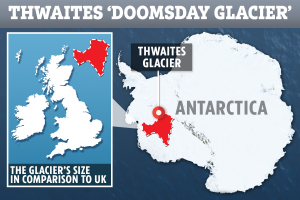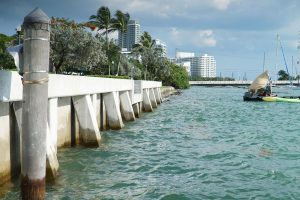The Thwaites Glacier, often called the Doomsday Glacier, is a rapidly melting glacier located in Western Antarctica. Many scientists believe this is one of the major effects of global warming.

The Doomsday Glacier is the widest glacier in the world, comparable to the size of Florida. If it fully melts, which it is on track to, coastlines across the entire world will be flooded. This isn’t a science fiction novel; it’s real life. Because part of the massive ice block is in the water, warm ocean water has begun to melt Thwaites from below. This is causing the glacier to lose its grip on land and start to slide into the ocean. Though it was once stable, ever since global warming started raising ocean temperatures, the glacier has been considered unstable.
Thwaites is at high risk of breaking apart and displacing huge chunks of ice into the ocean. While scientists have known this was inevitable for a while, new studies and satellite images have shown the glacier is melting and deteriorating at a faster rate than ever predicted. Huge parts may collapse soon, contributing to a large rise in sea levels globally. Eric Rignot, a glaciologist with the International Thwaites Glacier Collaboration fears “that this sector of Antarctica is already in a state of collapse”. If true, this could result in two feet, and potentially ten feet if it causes a domino effect with nearby glaciers, of sea level rise. This would cause major damage and destruction in places such as Florida. However, even more worrying is, that once it melts, there is no way to reverse it.

Coastal communities (such as Miami, Florida) have already started to prepare for sea level rise. Many of them have started creating sea walls, levees, and storm surge barriers (New York Times). New York has already started working on a nearly $120 billion climate plan that involves using sea walls (Columbia Climate School). Additionally, many of the communities have started raising streets and buildings to help prevent flood damage. Many governments in these areas have also started updating and publicizing flood plans to prepare. However, it’s not just the government that is preparing, citizens are too, with some moving inland to avoid the entire fiasco altogether.
However, they might be too late. Updated research in 2024 by the University of California and the International Thwaites Glacier Collaboration has shown that the Doomsday Glacier is bringing us towards Doomsday way quicker than ever realized. Glaciers exponentially melt quicker and quicker as rising sea levels from melted glaciers create rising sea temperatures, which just leads to more melting. Much of Thewaites is already too late to save and will be creating a noticeable impact within just a few decades–a relatively quick time frame for massive global change.
Despite this, any government action to help reduce the impact, or prevent further melting in other glaciers has been frustratingly slow. Scientists and world leaders know the situation is serious, yet little action has been taken. Many countries around the world have promised to cut greenhouse gas emissions (a contributing factor to warmer ocean temperatures), and agreements like the Paris Climate Agreement have been made, yet big contributors such as China have not followed it very well, and the United States plans to withdraw from it.
Too many governments still allow fossil fuels (such as coal, gas, and oil), and promises are repeatedly being broken for economic benefit. Countries are prioritizing greed over the safety and well-being of our planet. As a result, global temperatures keep rising, and glaciers like Thwaites keep on melting.

Luckily, scientists have been studying the Doomsday Glacier more than ever before, even sending robotic submarines under the ice to gain information. These efforts, coupled with satellite imaging, have been able to confidently predict what may happen next, and the effects that the melting has already caused on the planet. Hopefully, with this information, governments will start to plan around global warming now realizing the true effects it has.
Unfortunately, no matter what, Thwaites will suffer irreversible damage. Even if we stop all pollution and contributing factors right now, the glacier is too unstable to fully recover. However, we can slow it down and we can prevent further damage. Action needs to be made, and it needs to be made now. If governments won’t make a change, it’s up to us. Use renewable energy, recycle, don’t waste, use public transport, and do research. But most importantly, speak up!



















